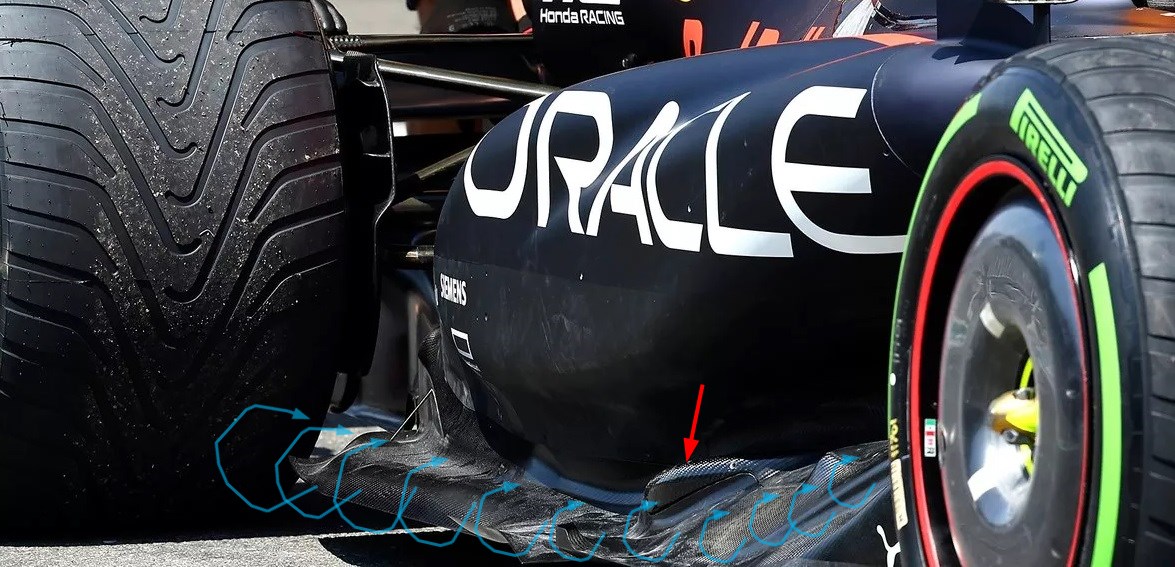No, this is medium load wing.
- Login or Register
No account yet? Sign up

The arrow points to the scalloped feature of the floor that was part of the Spain package, just to be clearGrrG wrote: ↑17 Jun 2022, 10:27Baku update of Red Bull RB18! Floor fence, floor side and diffuser
https://pbs.twimg.com/media/FVbFN1RakAI ... ame=medium
Looking at this mechanism I have a thought about how it might be configured to help with porpoising and high speed braking. Newey has said that he was particularly involved in the suspension, maybe he included this area?
Two things I note. Firstly it is quite stiff, the forces are quite high for quite small movements of this section of the floor. Secondly, the regs are concerned about hysteresis, the bolded part. However there is no mention of how quickly the load is applied or removed.At all times during the test, the load at a given deflection must exceed the load given by a straight-line graph defined by connecting the following coordinates in order: (0 mm, 0 N) (1 mm, 0 N) (5 mm, 4000N) (25mm, 6000N). This must be the case whether the deflection is increasing, decreasing, or held constant. The test will have no more than a maximum load of 8000N or a maximum deflection of 15mm (whichever is reached first) unless specifically requested by the FIA to investigate behaviour above these limits.
The load deflection relationship must be strictly monotonic with both increasing and decreasing deflection
The damping is the key point there, it should stop any tendency of hysteresis.henry wrote: ↑17 Jun 2022, 15:21Looking at this mechanism I have a thought about how it might be configured to help with porpoising and high speed braking. Newey has said that he was particularly involved in the suspension, maybe he included this area?
The load response of this mechanism is covered by 3.15.6 in the regulations.
Two things I note. Firstly it is quite stiff, the forces are quite high for quite small movements of this section of the floor. Secondly, the regs are concerned about hysteresis, the bolded part. However there is no mention of how quickly the load is applied or removed.At all times during the test, the load at a given deflection must exceed the load given by a straight-line graph defined by connecting the following coordinates in order: (0 mm, 0 N) (1 mm, 0 N) (5 mm, 4000N) (25mm, 6000N). This must be the case whether the deflection is increasing, decreasing, or held constant. The test will have no more than a maximum load of 8000N or a maximum deflection of 15mm (whichever is reached first) unless specifically requested by the FIA to investigate behaviour above these limits.
The load deflection relationship must be strictly monotonic with both increasing and decreasing deflection
If the car starts to porpoise, perhaps it hits a bump the road, load on this part of the floor will increase, and then the aero load goes down and the car is pushed up with a force which is the difference between aero load and the sum of the load from the suspension springs, including the tyres, and the floor mechanism. If the floor has hysteresis, as the car starts to lift the floor’s contribution to the upward force, and hence movement will decrease. If the hysteresis is high enough it will lose contact with the road, the load it provides goes to zero and a gap will open allowing air flow under the plank. This would reduce the vigorous and amplitude of porpoising.
The porpoising frequency is around 6hz. I doubt very much that the measurement mechanism applies loads at anything like that rate. The spring elements, Belleville washers are notorious for hysteresis and who knows what damping mechanism there is in the strut.
In high speed braking there is a load transfer to the front of the car, for a 5g stop around 3500N. This will compress the front suspension and tyres and likely load up the front of the floor. This might reduce the braking force and stability. With hysteresis, as soon as the speed reduces the front of the car will rise and the contact force of the floor to the road will drop, perhaps to zero, increasing braking force, improving stability and possibly allowing greater air flow to the floor.
For both these potential mechanisms running the car with a small amount of rake would be needed. I don’t think it’s possible to easily judge rake on these cars given the configuration and flexibility of the floor edge.
This is not necessarily exclusive to RB18, other cars have mechanisms here but the RB one is easy to observe.
johnny comelately wrote: ↑17 Jun 2022, 15:30The damping is the key point there, it should stop any tendency of hysteresis.henry wrote: ↑17 Jun 2022, 15:21Looking at this mechanism I have a thought about how it might be configured to help with porpoising and high speed braking. Newey has said that he was particularly involved in the suspension, maybe he included this area?
The load response of this mechanism is covered by 3.15.6 in the regulations.
Two things I note. Firstly it is quite stiff, the forces are quite high for quite small movements of this section of the floor. Secondly, the regs are concerned about hysteresis, the bolded part. However there is no mention of how quickly the load is applied or removed.At all times during the test, the load at a given deflection must exceed the load given by a straight-line graph defined by connecting the following coordinates in order: (0 mm, 0 N) (1 mm, 0 N) (5 mm, 4000N) (25mm, 6000N). This must be the case whether the deflection is increasing, decreasing, or held constant. The test will have no more than a maximum load of 8000N or a maximum deflection of 15mm (whichever is reached first) unless specifically requested by the FIA to investigate behaviour above these limits.
The load deflection relationship must be strictly monotonic with both increasing and decreasing deflection
If the car starts to porpoise, perhaps it hits a bump the road, load on this part of the floor will increase, and then the aero load goes down and the car is pushed up with a force which is the difference between aero load and the sum of the load from the suspension springs, including the tyres, and the floor mechanism. If the floor has hysteresis, as the car starts to lift the floor’s contribution to the upward force, and hence movement will decrease. If the hysteresis is high enough it will lose contact with the road, the load it provides goes to zero and a gap will open allowing air flow under the plank. This would reduce the vigorous and amplitude of porpoising.
The porpoising frequency is around 6hz. I doubt very much that the measurement mechanism applies loads at anything like that rate. The spring elements, Belleville washers are notorious for hysteresis and who knows what damping mechanism there is in the strut.
In high speed braking there is a load transfer to the front of the car, for a 5g stop around 3500N. This will compress the front suspension and tyres and likely load up the front of the floor. This might reduce the braking force and stability. With hysteresis, as soon as the speed reduces the front of the car will rise and the contact force of the floor to the road will drop, perhaps to zero, increasing braking force, improving stability and possibly allowing greater air flow to the floor.
For both these potential mechanisms running the car with a small amount of rake would be needed. I don’t think it’s possible to easily judge rake on these cars given the configuration and flexibility of the floor edge.
This is not necessarily exclusive to RB18, other cars have mechanisms here but the RB one is easy to observe.
Are you sure about 6 hz?


It's like the dug a hole in the middle of the factory, put three engineers in it with some food rations and carving tools, sealed it with a giant slab of wood and told them they wont be relased until they carved out a masterpeice of a floor!
I wonder if they look the same once there is some air pressure involved?GrizzleBoy wrote: ↑18 Jun 2022, 00:29Every time I see a new angle of those strakes it makes me feel like I have to reconfigure everything about what I thought they were doing lol.
For instance that middle strake in the top picture almost looks in washing, but I'm sure the angle is hiding the last portion of the strake that flicks outward when seen from below.
Good point! I'm sure it would be very difficult to enforce the "no movable aero parts" when it's not visible.Big Tea wrote: ↑18 Jun 2022, 00:31I wonder if they look the same once there is some air pressure involved?GrizzleBoy wrote: ↑18 Jun 2022, 00:29Every time I see a new angle of those strakes it makes me feel like I have to reconfigure everything about what I thought they were doing lol.
For instance that middle strake in the top picture almost looks in washing, but I'm sure the angle is hiding the last portion of the strake that flicks outward when seen from below.

